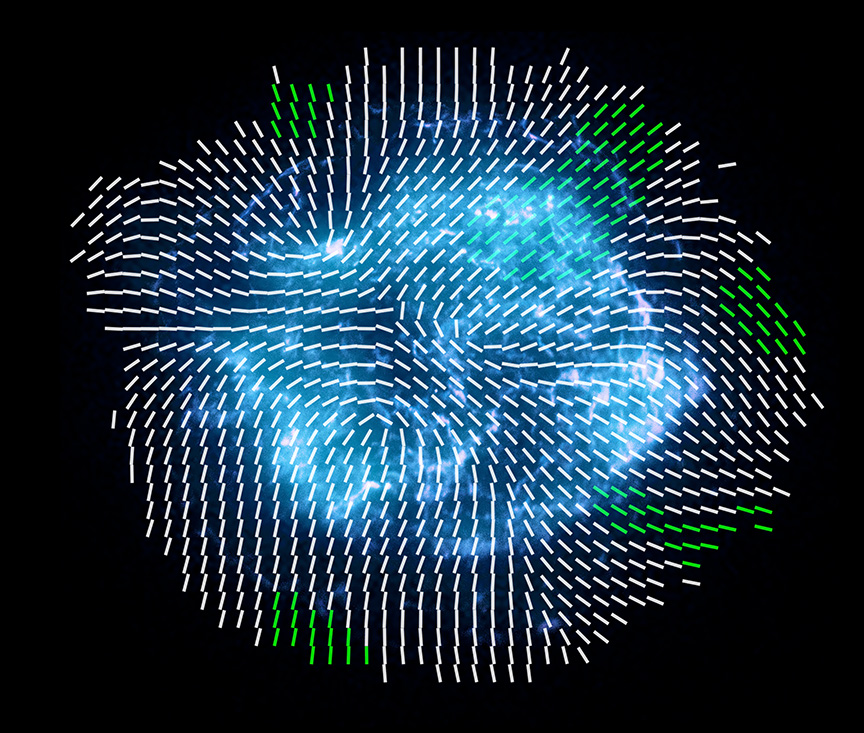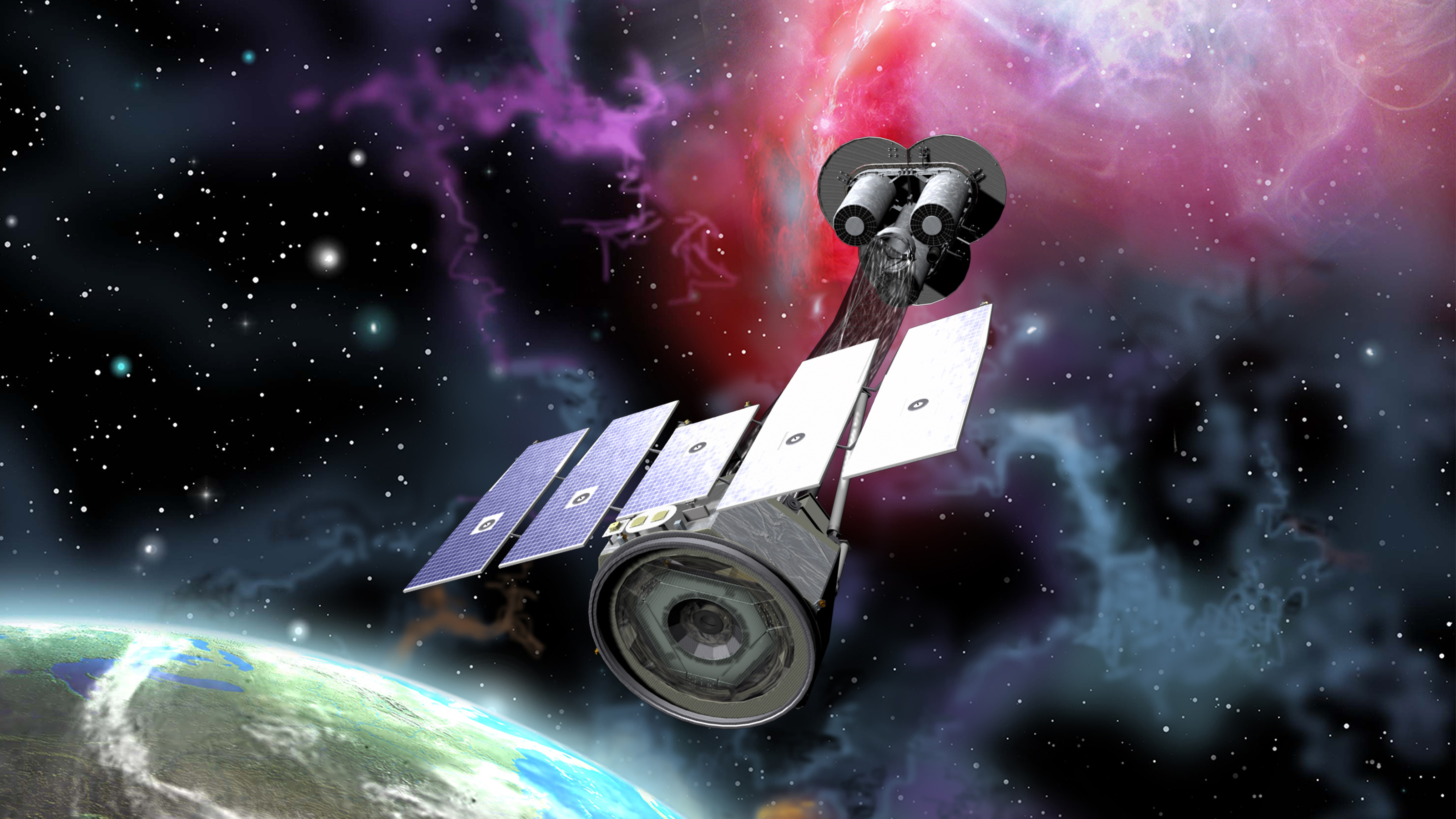X-ray view of wreckage from a star-killing cosmic explosion reveals magnetic surprise
Using NASA's IXPE space observatory astronomers have mapped polarized X-rays from Cassiopeia A the remains of a massive star that went supernova.

The polarization of X-rays coming from the remains of a distant exploded star has been measured and mapped for the first time by astronomers.
The results collected from the stellar wreckage known as Cassiopeia A (Cas A) could shed new light on the nature of young supernova remnants and their magnetic fields, which can accelerate particles to near the speed of light.
The findings represent a new way of reconstructing the explosive death of massive stars as they become supernovas — a process that seeds the universe with elements that become the building blocks of the next generation of stars.
Related: Soar Through the Heart of a Supernova in This Gorgeous New Simulation
Astronomers collected X-ray data from Cas A — located 11,000 light-years away in the constellation Cassiopeia — using the Imaging X-ray Polarimetry Explorer (IXPE) space observatory.
The first object that IXPE began observing after its launch in December 2021, Cas A, was selected because the shock waves generated from the supernova that created it are some of the fastest in the Milky Way.
The shockwaves were created when a massive star ran out of fuel for nuclear fusion and could no longer support itself against gravitational collapse. As the core of the star collapsed, it triggered a massive supernova and sent these shockwaves through what was once the star's outer layers.
Get the Space.com Newsletter
Breaking space news, the latest updates on rocket launches, skywatching events and more!
Light from the destruction of this massive star and the creation of the Cas A stellar wreckage — which is around 29 light-years wide — swept over Earth over 300 years ago.
In the extreme conditions found around supernova remnants like Cas A, magnetic fields grab charged particles like electrons and protons and accelerate them to speeds approaching that of light. These particles are, despite their super-speed, trapped around supernova remnants traveling in curved paths.
When charged particles travel along curved paths at speeds near that of light — or relativistic speeds — they generate an intense form of light called synchrotron radiation. This radiation escapes the supernova remnant across a range of wavelengths of light including low-energy radio waves and high-energy X-rays.
This radiation is polarized by magnetic fields regardless of its wavelength, meaning that encoded within it is information about the magnetic field of the supernova remains from which it originates.
Now, thanks to IXPE data, astronomers can measure this polarization for X-ray light and thus unlock the secrets of the magnetic fields around Cas A.
"Without IXPE, we have been missing crucial information about objects like Cas A," Center for Astrophysics at Harvard & Smithsonian, Pat Slane, who leads the IXPE investigations of supernova remnants, said in a statement. "This result is teaching us about a fundamental aspect of the debris from this exploded star — the behavior of its magnetic fields."
Studying the polarization of light from Cas A has enabled astronomers to reverse engineer the processes that are occurring within the supernova remnant at small scales. This has allowed them to gather details about Cas A and its magnetic field that are unobtainable in any other way.
Read more: The 'Ghost of Cassiopeia' Drifts Along in This Spooky Hubble Image

Reconstructing a star's explosive scene of death
The angle of polarization of the light from a supernova remnant reveals the direction of its magnetic field. Small amounts of polarization indicate that the magnetic fields are close to the leading shockwaves, or shockfront. This is because magnetic fields near a shockfront are tangled and chaotic, oriented in different directions resulting in less polarization.
"These IXPE results were not what we expected, but as scientists, we love being surprised," University of Amsterdam astrophysicist and lead author Jacco Vink said in the statement. "The fact that a smaller percentage of the X-ray light is polarized is a very interesting — and previously undetected — property of Cas A."
This low polarization implies that X-rays from Cas A are generated in turbulent regions with a mix of many different magnetic field directions.
"This study enshrines all the novelties that IXPE brings to astrophysics," said Riccardo Ferrazzoli, study co-author and researcher at the Italian National Institute for Astrophysics and Institute for Space Astrophysics and Planetology in Rome. "Not only did we obtain information on X-ray polarization properties for the first time for these sources, but we also know how these change in different regions of the supernova.
"As the first target of the IXPE observation campaign, Cas A provided an astrophysical 'laboratory' to test all the techniques and analysis tools that the team has developed in recent years."
Read more: NASA's newly launched X-ray space telescope is ready to start observing the cosmos

Observations of radio wave synchrotron radiation from Cas A with radio telescopes had previously shown that is produced in regions across almost the entire supernova remnant. Only a small amount of these radio waves — about 5% — are polarized. This radio wave data seems to indicate that the magnetic field of Cas A is oriented radially like the spokes of a bike wheel radiating out from its center to its outer rim.
Observations for higher energy X-ray synchrotron radiation taken by NASA's Chandra X-ray Observatory tell a different story, however. These higher energy emissions seemed to come from thin regions along the shockwaves, near the circular outer rim of Cas A, an area where the magnetic fields are predicted to align with the shocks.
Prior to IXPE, scientists predicted X-ray polarization would be produced by magnetic fields that are aligned at 90 degrees (perpendicular ) to magnetic fields that polarize the radio wave radiation.
IXPE X-ray data suggest instead that the magnetic fields that polarize this high-energy light are aligned radially and are located close to the shockfront. The X-rays from Cas A also seem to possess a lower amount of polarization than even the radio waves.
IXPE will now be used to study other supernova remnants. Astronomers expect each observation to reveal new information about these violent cosmic explosions and the environments they create.
"These results provide a unique view of the environment necessary to accelerate electrons to incredibly high energies," research co-author and University of Amsterdam researcher, Dmitry Prokhorov, said. "We are just at the beginning of this detective story, but so far the IXPE data are providing new leads for us to track down."
The team's research is detailed in a paper posted to the preprint server ArXiv.
Follow us on Twitter @Spacedotcom or on Facebook.
Join our Space Forums to keep talking space on the latest missions, night sky and more! And if you have a news tip, correction or comment, let us know at: community@space.com.

Robert Lea is a science journalist in the U.K. whose articles have been published in Physics World, New Scientist, Astronomy Magazine, All About Space, Newsweek and ZME Science. He also writes about science communication for Elsevier and the European Journal of Physics. Rob holds a bachelor of science degree in physics and astronomy from the U.K.’s Open University. Follow him on Twitter @sciencef1rst.









